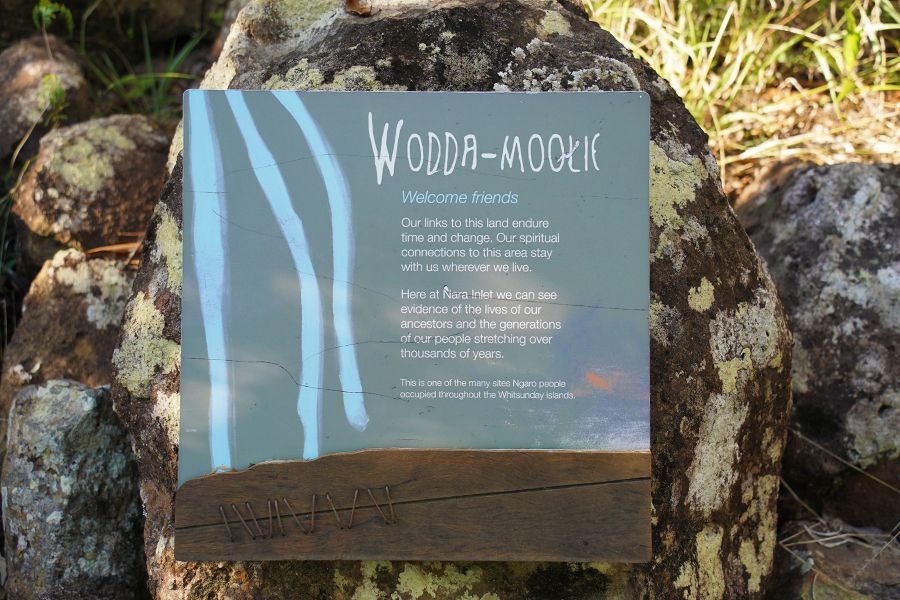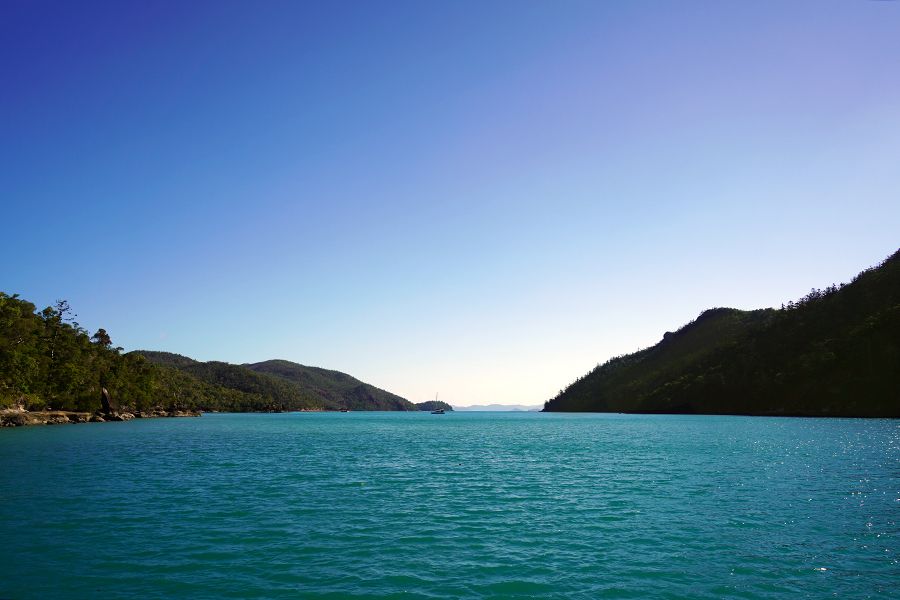Ngaro Cultural Site, Hook Island

During your adventures through the naturally abundant Whitsunday Islands on Ngaro Country, there is no better way to learn, reflect and pay respect to history than by visiting the Ngaro Cultural Site. Tucked away in Nara Inlet on Hook Island, the Ngaro Cultural Site is home to ancient Indigenous cave paintings, sacred stories old and new, as well as plentiful archeological insights.
As the oldest Indigenous site on the whole of Australia’s East Coast, this piece of history is an unmissable stop on your next island journey. A beautifully curated, extra-special site steeped in valuable history and lush flora and fauna. Transport yourself 9,000 years back in time and pause to reflect on the history of the Ngaro people.
The Ngaro Cultural Site Walk

The Ngaro Cultural Walk delivers visitors straight to the mouth of the cave via a boardwalk and set of stairs in roughly 5 to 10 minutes. As there are some intermittent (but brief) inclines a basic level of fitness is required to reach the ancient cave paintings. Find out more about the boardwalk and track of the Ngaro Cultural Site with our Whitsunday Walk guide.
The Ngaro were able to create vivid and long-lasting paintings by using red and yellow ochres (most likely quarried from South Molle Island) and heating them over hot coals with white kaolin (clay). The natural paint pigments were applied to the rockface with both fingers and stick brushes created by grinding or chewing the end of a stick.
These sacred paintings have been protected from weather and some erosion by the cave’s shelter. In further efforts to preserve the paintings’ longevity, rangers have erected boardwalks and electric fences to keep Hook Island’s wild goats from rubbing against the rockface. Ngaro representatives have also advised Queensland Park and Wildlife that visitors must remain outside of the shelter. However, this won’t stop you from a clear and comprehensive view from the fenced viewing platform.
Over 9,000 years after the paintings’ origins, visitors and researchers can only speculate on their original intent and meaning. The society and history of the Ngaro has been shamefully and egregiously erased by colonial Australians. In 1870, any Ngaro people who had thus far evaded massacre or enlistment in the Australian Native Police Corps were forcibly removed from their lands and displaced on Palm and Brampton islands. Both the massacring and displacement of the Ngaro people have resulted in the loss of thousands of years of knowledge and culture.
Ngaro history

Did you know that 9,000 years ago, the entrance to Nara Inlet was still a part of the mainland? During this time, the Ngaro came and went but rarely stayed on this part of the mainland, as it was predominantly a place to gather food from the abundant forests and valleys.
Over many thousands of years, rising ocean levels created inlets and gave rise to the islands we see today. And as the landscape dramatically changed, so too did the lifestyles and skills of the Ngaro. They became a seafaring people who travelled via sophisticated canoes and began to base their lives on what we now call Hook Island, as a greater reliance on the bountiful sea allowed for plentiful food access. Extracts from colonial European diaries describe the Ngaro people utilising fishing spears, lines and hooks cut out of tortoiseshell. They also cultivated treatments and remedies for poisonous pandanus fruits and cycads.
From the 1860s to the 1930s, the Ngaro population was predominantly decimated during and following European invasion, in which entire Indigenous communities were murdered, forcibly removed to mission camps and discriminated against. By the 1930s, incredibly few Ngaro peoples remained on the islands other than those employed by white settlers.
The erasure and discrimination of Indigenous people and their culture are evident today, as Australia’s history of violence and segregation continues to disproprotionately impact First Nations peoples. While sombre and harrowing, it is vehement that we learn, acknowledge and reflect on the hard truths about white Australia's sordid history.
How to get to Nara Inlet

A dreamy, secluded and calm spot nestled in Hook Island, Nara Inlet is an absolute dream to sail into. With lush rainforest on either side of the protected channel, this stunning section of the islands is a relaxed, postcard-worthy, must-visit spot!
Getting to Nara Inlet is typically done through a longer overnight charter, with plenty of flexibility. Just let your skipper know in advance that you would like to sail to Nara Inlet, conditions permitting. We recommend taking a longer tour, such as a 3-day and 3-night sail, to ensure that there is plenty of time and flexibility to make it to the Ngaro Cultural Site.
As of September 2024, Lady Enid also runs a unique cultural day tour that visits the Ngaro Cultural site.
Alternatively, a private charter will give you and your guests the freedom and flexibility to choose your own adventure and set sail to the Ngaro Cultural Site at your own pace. Nara Inlet is a popular spot for overnight sailing groups to anchor for the evening due to the calm, protected conditions and lush surrounding forests. Chat to our friendly team of locals to find the best, tailored island experience that will deliver you to Nara Inlet today!
Visit Ngaro Cultural Site With These Unmissable Trips













